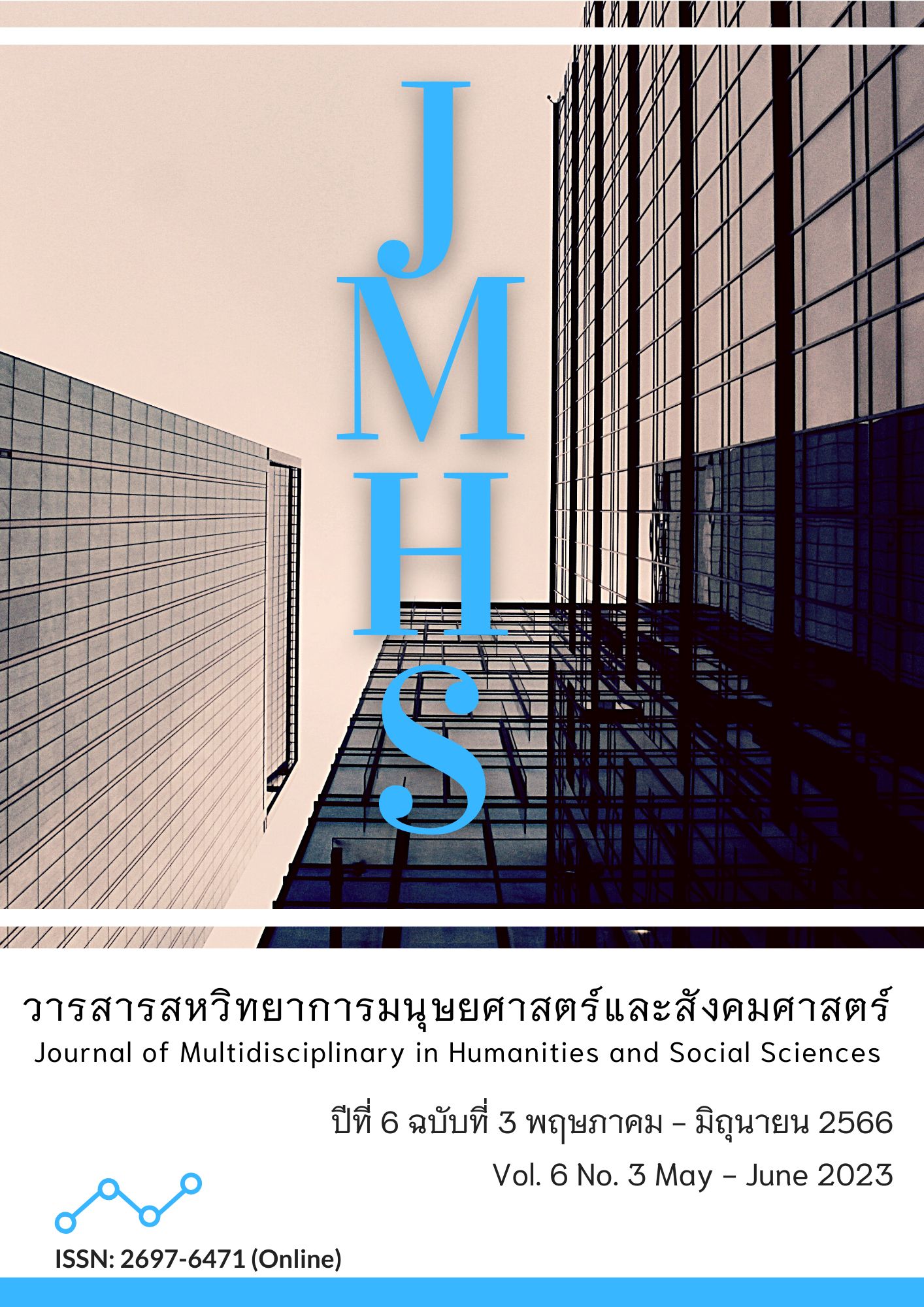ปัจจัยที่มีอิทธิพลต่อการบอกต่อแบบปากต่อปากของผู้บริโภคสินค้าออนไลน์ในประเทศไทย
Main Article Content
บทคัดย่อ
บทความวิจัยนี้นำเสนอปัจจัยที่มีอิทธิพลต่อการบอกต่อแบบปากต่อปากของผู้บริโภคสินค้าออนไลน์ในประเทศไทยมีวัตถุประสงค์เพื่อศึกษา 1) ระดับการบอกต่อแบบปากต่อปากของผู้บริโภคสินค้าออนไลน์ในประเทศไทย และ 2) ปัจจัยเชิงสาเหตุที่มีอิทธิพลต่อการบอกต่อแบบปากต่อปากของผู้บริโภคสินค้าออนไลน์ในประเทศไทย การวิจัยครั้งนี้เป็นการวิจัยเชิงปริมาณ เครื่องมือคือแบบสอบถาม กลุ่มตัวอย่างคือ ผู้บริโภคที่ซื้อสินค้าผ่านระบบออนไลน์ในประเทศไทย จำนวน 377 คน สุ่มตัวอย่างแบบโควตา ใช้สถิติพรรณนา และสถิติอ้างอิง
ผลการวิจัยพบว่า ระดับการบอกต่อแบบปากต่อปาก ภาพรวมอยู่ในระดับมาก (ค่าเฉลี่ย = 4.03) และรายด้านอยู่ในระดับมากเช่นเดียวกัน โดยด้านเนื้อหา (ค่าเฉลี่ย = 4.08) ด้านคุณค่าทางความคิดเห็น (ค่าเฉลี่ย = 4.01) และด้านความหนาแน่น (ค่าเฉลี่ย = 3.99) คุณภาพบริการอิเล็กทรอนิกส์มีอิทธิพลทางตรงต่อการบอกต่อแบบปากต่อปากอย่างไม่มีนัยสำคัญทางสถิติ (ขนาดอิทธิพล = 0.12) การรับรู้คุณค่าตราสินค้ามีอิทธิพลทางตรงต่อการบอกต่อแบบปากต่อปากอย่างมีนัยสำคัญทางสถิติ (ขนาดอิทธิพล = 0.79) และคุณภาพบริการอิเล็กทรอนิกส์มีอิทธิพลทางอ้อมต่อการบอกต่อแบบปากต่อปากผ่านการรับรู้คุณค่าตราสินค้าอย่างมีนัยสำคัญทางสถิติ (ขนาดอิทธิพล = 0.69) ข้อค้นพบจากงานวิจัยจะเป็นประโยชน์ต่อผู้ประกอบการธุรกิจออนไลน์ในประเทศไทย ในการพัฒนากลยุทธ์การบอกต่อแบบปากต่อปาก ผ่านคุณภาพบริการอิเล็กทรอนิกส์ และการรับรู้คุณค่าตราสินค้า
Article Details

อนุญาตภายใต้เงื่อนไข Creative Commons Attribution-NonCommercial-NoDerivatives 4.0 International License.
ทัศนะและความคิดเห็นที่ปรากฏในวารสาร ถือเป็นความรับผิดชอบของผู้เขียนบทความนั้น และไม่ถือเป็นทัศนะและความรับผิดชอบของกองบรรณาธิการ
เอกสารอ้างอิง
กระทรวงดิจิทัลเพื่อเศรษฐกิจและสังคม. (2564). ดีอีเอส เปิดสถิติ 15 ปัญหาซื้อขายทางออนไลน์ในรอบปี 64. สืบค้นเมื่อ 20 เมษายน 2566, จาก https://www.mdes.go.th/news/detail/51765-64
เพ็ญศิรินทร์ สุขสมกิจ และ อดิลักษณ์ พุ่มอิ่ม. (2565). การพัฒนาโมเดลเชิงสาเหตุของปัจจัยส่วนประสมทางการตลาด และ คุณภาพการให้บริการทางออนไลน์ ที่มีอิทธิพลต่อคุณค่าตราสินค้า สำหรับตลาดกลางอิเล็กทรอนิกส์ในประเทศไทย. วารสารการบัญชีและการจัดการ มหาวิทยาสัยมทาสารคาม, 14(2), 125-142. สืบค้นจาก https://so02.tci-thaijo.org/index.php/mbs/article/download/250359/172543/965066
ศูนย์วิจัยกสิกรไทย. (2565). E-Commerce โตต่อ...แม้ชะลอลง มูลค่าตลาด B2C E-Commerce ช่วง 3 ปีที่ผ่านมาขยายตัวเฉลี่ย 26% ต่อปี คาด...ปี 66 ขยายตัว 4-6% กินส่วนแบ่งต่อตลาดค้าปลีกรวม 16%. สืบค้นเมื่อ 12 มกราคม 2566, จาก https://www.kasikornresearch.com/th/analysis/k-social-media/Pages/B2C-FB-02-12-2022.aspx
สำนักงานพัฒนาธุรกรรมทางอิเล็กทรอนิกส์. (2564). ETDA เผยโควิด-19 เป็นเหตุสังเกตได้ Gen Z ใช้เน็ตสูงสุด ปีแรก ชนะ Gen Y แชมป์ 6 สมัย. สืบค้นเมื่อ 22 ตุลาคม 2565, จาก https://www.etda.or.th/th/pr-news/ETDA-released-IUB-2021.aspx
สำนักงานพัฒนาธุรกรรมทางอิเล็กทรอนิกส์. (2565). ETDA เผย Gen Y ทวงบัลลังก์ ใช้เน็ตมากสุด เกือบ 8 ชั่วโมงต่อวัน ฮิตสุด ดู LIVE COMMERCE ข้าราชการ-จนท.รัฐ ชนะขาดทุกอาชีพ ใช้เน็ตเกือบ 12 ชั่วโมงต่อวัน. สืบค้นเมื่อ 22 ตุลาคม 2565, จาก https://www.etda.or.th/th/pr-news/iub2022.aspx
สุพัตรา กาญจโนภาส, สมเดช รุ่งศรีสวัสดิ์ และ บัณฑิต ผังนิรันดร์. (2562). อิทธิพลของนวัตกรรมการจัดการคุณภาพการบริการอิเล็กทรอนิกส์ความไว้วางใจ และคุณค่าตราสินค้าที่มีต่อพฤติกรรมผู้บริโภคของธุรกิจตัวแทนการท่องเที่ยวแบบออนไลน์ในประเทศไทย. วารสารสมาคมนักวิจัย, 24(1), 58-71. สืบค้นจาก https://so03.tci-thaijo.org/index.php/Logis_j/article/view/256008
แสงอรุณ วรากุลศิริศักดิ์ และ อุมาวรรณ วาทกิจ. (2564). คุณภาพการบริการที่มีความสัมพันธ์กับการสื่อสารแบบบอกต่อของธุรกิจสปาในเขตเทศบาลเมืองมหาสารคาม จังหวัดมหาสารคาม. วารสารวิชาการและวิจัย มหาวิทยาลัยภาคตะวันออกเฉียงเหนือ, 11(1), 87-99. สืบค้นจาก https://so04.tci-thaijo.org/index.php/neuarj/article/view/246143
อมรรัตน์ แย้มรส และ รุจิภาส โพธิ์ทองแสงอรุณ. (2562). ความสัมพันธ์ของคุณภาพบริการ คุณค่าตราสินค้าต่อความจงรักภักดีเชิงทัศนคติ และเชิงพฤติกรรมของผู้ใช้บริการโรงพยาบาลเอกชนที่ไม่ได้มุ่งแสวงหากำไรในเขตกรุงเทพมหานคร. วารสารวิชาการ สถาบันเทคโนโลยีแห่งสุวรรณภูมิ, 5(1), 50-62. สืบค้นจาก https://so04.tci-thaijo.org/index.php/svittj/article/download/194572/136874/595320
Aaker, D. A. (1991). Managing brand equity: Capitalizing on the value of a brand name. New York, NY: Free Press.
Berry, L. L, Parasuraman, A., & Zeithaml, V. A. (1994). Improving service quality in America: Lessons learned. Academy of Management Perspectives, 8(2), 420-450. http://dx.doi.org/10.5465/AME.1994.9503101072
Diamantopoulous, A., & Siguaw, A. D. (2000). Introducing LISREL: A guide for the uninitiated. London: Sage Publications.
Elliot, R., & Percy, L. (2007). Strategic brand management. Oxford: Oxford University Press.
Faul, F., Erdfelder, E., Buchner, A., & Lang, A. (2009). Statistical power analyses using G*Power 3.1: Tests for correlation and regression analyses. Behavior Research Methods, 41, 1149-1160. https://doi.org/10.3758/BRM.41.4.1149
Goyette, I., Richard, L., Bergeron, J., & Marticotte, F. (2010). e-WOM Scale: Word-of-Mouth Measurement Scale for e-Services Context. Canadian Journal of Administrative Sciences / Revue Canadienne des Sciences de l’ Administration, 27, 5-23. http://dx.doi.org/10.1002/cjas.129
Hu, L.T., & Bentler, P.M. (1999). Cutoff criteria for fit indexes in covariance structure analysis: Conventional criteria versus new alternatives. Structural Equation Modeling, 6(1), 1-55. https://doi.org/10.1080/10705519909540118
Langga, A., Kusumawati, A., & Alhabsji, T. (2021). Intensive distribution and sales promotion for improving customer-based brand equity (CBBE), re-purchase intention and word-of-mouth (WOM). Journal of Economic and Administrative Sciences, 37(4), 577-595. https://doi.org/10.1108/JEAS-03-2019-0041
Li, S., Nathan, R., Ragu-Nathan, T., & Rao, S. (2006). The impact of supply chain management practices on competitive advantage and organizational performance. The International Journal of Management Science Omega, 34(2), 107-124. http://dx.doi.org/10.1016/j.omega.2004.08.002
Parasuraman, A., Zeithaml, V. A., & Malhotra, A. (2005). E-S-QUAL: a multiple-item scale for assessing electronic service quality. Journal of Service Research, 7(3), 213-233. https://doi.org/10.1177/1094670504271156
Royne, B. M., Stafford, F. T., & Day, E. (2002). A Contingency Approach: The Effects of Spokesperson Type and Service Type on Service Advertising Perceptions. Journal of Advertising, 31(2), 17-35. http://dx.doi.org/10.1080/00913367.2002.10673664
Solomon, R. M. (2011). Consumer behavior: Buying, having, and being (9th ed.). Upper Saddle River, New Jersey: Prentice-Hall.
We Are Social & Hootsuite. (2020). Digital 2020: July Global Statshot. Retrieved January 25, 2023, from https://datareportal.com/reports/digital-2020-july-global-statshot
Wei, L., & Intakhan, P. (2021). The Relationship between Service Quality, Positive Word of Mouth and Customer Satisfaction of Foreign Restaurant Customers in Lampang Province, Thailand. Journal of Management Science Pibulsongkram Rajabhat University, 3(3), 119-140. Retrieved from https://so03.tci-thaijo.org/index.php/jmspsru/article/view/257155
Wei-Long Lee, Chih-Hsing Liu., & Tzu-Wen Tseng. (2022).The multiple effects of service innovation and quality on transitional and electronic word-of-mouth in predicting customer behavior. Journal of Retailing and Consumer Services, 64, 102791, https://doi.org/10.1016/j.jretconser.2021.102791.
Yoo, B., & Donthu, N. (2001). Developing a scale to measure the perceived quality of internet shopping sites (SITEQUAL). Quarterly Journal of Electronic Commerce, 2(1), 31-47. http://dx.doi.org/10.1007/978-3-319-11885-7_129
Zairi, M. (2000). Managing customer satisfaction: A best practice perspective. The TQM Magazine, 12(6), 389-394. https://doi.org/10.1108/09544780010351670


